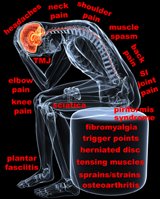Neutralizing your pain sensitivity: a new way to look at recovering from persistent pain
Understanding pain has actually been found to help in recovery. Pain is a complex, two-headed monster. One head might represent 'normal' pain which occurs when body tissues are being damaged (cut, crushed, broken, bruised, etc.) or when there is potential for damage (tissues are being stretched or compressed beyond normal). The second head of the pain monster is chronic pain.
Chronic pain is different than normal pain perception. The body parts involved (nerves, muscles, tendons, fascia, periosteum, joints, etc) have become generally unhealthy. And therefore, a chronic pain signal does not necessarily mean that damage is ocurring. In fact, light touch (with virtually no potential for bodily harm) can create the perception of pain. When the perception of pain is heightened or amplified we call this "pain sensitivity."
The nerve receptors in our muscles, fascia, and joints may become sensitized to sending unnecessary pain messages to the brain. Furthermore, the large nerves, spinal cord, and even the brain may become sensitized to sending and perceiving a pain message.
A trigger point in a muscle is an example of one of these pain "amplifiers." And similarly, Dr. John E. Sarno has described this phenomenon as tension myositis syndrome. Perhaps it should be called tension neuro-myo-fasciitis syndrome, because each of the three (nerve, muscle, or fascia) can participate as amplifiers of persistent pain.
Additionally, pain sensitivity has a psychological or emotional component that is related to stress. This part of the equation involves the primitive brain, or more specifically a region called the amygdala. This part of the primitive brain has been described as the "threat center," "fear center," or "emotional center" of the human brain. Thereby, negative emotional energy created by fear, anger, and despair is the fuel that runs the chronic pain cycle.
Emotions amplify your pain sensitivity
"Emotions - or mood - can alter how we react to pain since they're interlinked," says lead author Mathieu Roy, who completed the study as a Université de Montréal PhD student and is now a post-doctoral fellow at Columbia University. "Our tests revealed when pain is perceived by our brain and how that pain can be amplified when combined with negative emotions."
The amygdala, when left unchecked (by consciously meditating to connect the mind-body), will respond to pain perception by tensing muscles (facial grimacing or body cringing) and releasing stress-hormones to heighten the sensitivity of the nervous system. Both of these responses are pain amplifiers.
One last factor that helps us understand chronic pain is something that fails to happen. With normal pain, once the signal has been received and perceived, a natural endorphine (similar to an opiate drug) is released to stop or reduce the pain signal where it enters in the spinal cord. In chronic pain, this pain desensitizing phenomenon no longer occurs.
